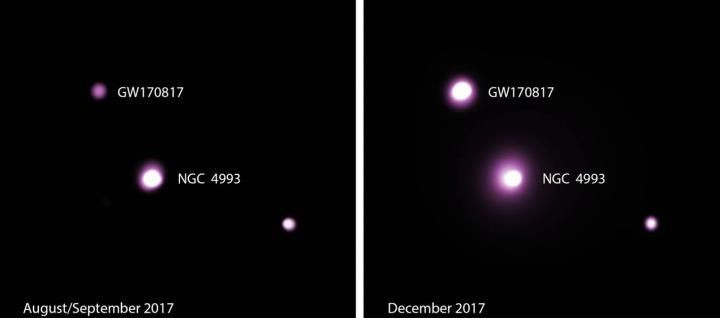Neutron Star Merger That Produced Gravitational Waves Is Getting Brighter, But Why?

Following the merger of two neutron stars, the gamma-ray burst that is produced would get brighter for a short period of time, and then fade away, according to other observations of short gamma-ray bursts. But that is not what happened in the case of GW170817, the first neutron star merger observed by scientists in August last year, an event that also sent gravitational waves rippling through the universe.
If anything, the X-ray emission from the merged object has continued to grow in intensity, as have radio emissions from it. Radio wave data from the merger was tracked since the event occurred, but X-ray observations had to be suspended just over two weeks after it happened because the object’s location in the sky was too close to the sun.
In a paper published Thursday, researchers led by a team from Canada’s McGill University considered the various theoretical models that would allow for the afterglow of the merger to keep getting brighter (it has become about four times brighter since the merger). They used data collected by NASA’s Chandra X-ray Observatory.
“When the source emerged from that blind spot in the sky in early December, our Chandra team jumped at the chance to see what was going on. Sure enough, the afterglow turned out to be brighter in the X-ray wavelengths, just as it was in the radio,” John Ruan, a postdoctoral researcher at the McGill Space Institute and lead author of the new paper, said in a statement Thursday.

One of the models they considered was the cocoon formation theory, which was posited by another team of researchers in December. In brief, the theory suggests that the black hole which likely formed as a result of the merger was surrounded by debris that resulted from the collision between the neutron stars. The high-energy jets that would flow outward from the black hole’s poles, and would be observed as short gamma-ray bursts, got trapped by the debris, and the interaction shaped the debris into a cocoon that absorbed all that energy, making the object glow brighter in X-ray and radio wavelengths.
“Usually when we see a short gamma-ray burst, the jet emission generated gets bright for a short time as it smashes into the surrounding medium — then fades as the system stops injecting energy into the outflow. This one is different; it’s definitely not a simple, plain-Jane narrow jet,” McGill astrophysicist Daryl Haggard, whose research group led the new study, said.
“We show that the X-ray light curve is a good match to predictions from outflow models, in which the outflow is a cocoon, dynamical ejecta, or a structured jet. Our observations thus support a scenario in which both the X-ray and radio emission are the afterglow of an outflow, although the exact origin of the outflow is still uncertain,” the researchers wrote in the study.
The open-access paper, titled “Brightening X-Ray Emission from GW170817/GRB 170817A: Further Evidence for an Outflow,” appeared in the Astrophysical Journal Letters.
© Copyright IBTimes 2024. All rights reserved.





















